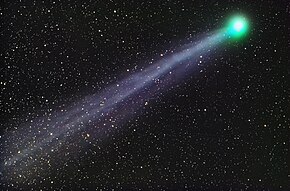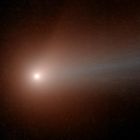C/2014 Q2 (Lovejoy)
 C/2014 Q2 as imaged 19 January 2015[1] | |
| Discovery | |
|---|---|
| Discovered by | Terry Lovejoy 0.2-m Schmidt (Q80)[2] |
| Discovery date | 17 August 2014 |
| Orbital characteristics | |
| Epoch | 18 January 2015[3] |
| Perihelion | 1.29077 AU (q)[3] |
| Eccentricity | 0.99811[3] |
| Orbital period | ~11000 years inbound (Barycentric solution for epoch 1950)[4] ~8000 years outbound (Barycentric solution for epoch 2050)[4] |
| Inclination | 80.301°[3] |
| Last perihelion | 30 January 2015[3] |
C/2014 Q2 (Lovejoy) is a long-period comet discovered on 17 August 2014 by Terry Lovejoy using a 0.2-meter (8 in) Schmidt–Cassegrain telescope.[2] It was discovered at apparent magnitude 15 in the southern constellation of Puppis.[2] It is the fifth comet discovered by Terry Lovejoy. Its blue-green glow is the result of organic molecules (mostly Diatomic carbon) and water released by the comet fluorescing under the intense UV and optical light of the Sun as it passes through space.[5][6]
History
[edit]By December 2014, the comet had brightened to roughly magnitude 7.4,[7] making it a small telescope and binoculars target. By mid-December, the comet was visible to the naked eye for experienced observers with dark skies and keen eyesight.[8] On 28–29 December 2014, the comet passed 1/3° from globular cluster Messier 79.[9] In January 2015, it brightened to roughly magnitude 4,[10] and became one of the brightest comets located high in a dark sky since comet C/1995 O1 (Hale-Bopp) in 1997. On 7 January 2015, the comet passed 0.469 AU (70,200,000 km; 43,600,000 mi) from Earth.[11] It crossed the celestial equator on 9 January 2015, becoming better seen from the Northern Hemisphere.[12] The comet came to perihelion (closest approach to the Sun) on 30 January 2015, at a distance of 1.29 AU (193,000,000 km; 120,000,000 mi) from the Sun.[3] At perihelion, its water production rate exceeded 20 metric tons per second.[5]
C/2014 Q2 originated from the Oort cloud,[5] but is not a dynamically new comet.[13] Before entering the planetary region (epoch 1950), C/2014 Q2 had an orbital period of about 11,000 years, with an aphelion about 995 AU (1.49×1011 km; 9.25×1010 mi) from the Sun.[4] After leaving the planetary region (epoch 2050), it will have an orbital period of about 8,000 years, with aphelion of about 800 AU.[4]
The comet was observed to release 21 different organic molecules in gas, including ethanol and glycolaldehyde, a simple sugar.[5][14] The presence of organic molecules suggests that they are preserved materials synthesized in the outskirts of the solar nebula or at earlier stages of the Solar System formation.[5]
Gallery
[edit]-
C/2014 Q2 glowing green over La Silla Observatory
-
C/2014 Q2 seen passing through Lepus, 29 December 2014
-
C/2014 Q2, 17 January 2015, with an 8" Schmidt–Cassegrain telescope
-
C/2014 Q2 and the Pleiades star cluster, 19 January 2015, with a DSLR
-
C/2014 Q2, 30 January 2015, NEOWISE
References
[edit]- ^ "Comet Lovejoy". Sky & Telescope. Retrieved 15 March 2015.
- ^ a b c "MPEC 2014-Q10 : COMET C/2014 Q2 (LOVEJOY)". IAU Minor Planet Center. 19 August 2014. Retrieved 14 September 2014. (CK14Q020)
- ^ a b c d e f "MPEC 2014-R69 : Observations and Orbits of Comets". IAU Minor Planet Center. 7 September 2014. Retrieved 14 September 2014.
- ^ a b c d Horizons output. "Barycentric Osculating Orbital Elements for Comet C/2014 Q2 (Lovejoy)". Retrieved 5 January 2015. (Solution using the Solar System Barycenter and barycentric coordinates. Select Ephemeris Type:Elements and Center:@0)
- ^ a b c d e Biver, Nicolas; Bockelée-Morvan, Dominique; Moreno, Raphaël; Crovisier, Jacques; Colom, Pierre; et al. (23 October 2015). "Ethyl alcohol and sugar in comet C/2014 Q2 (Lovejoy)". Science Advances. 1 (9). e1500863. arXiv:1511.04999. Bibcode:2015SciA....1E0863B. doi:10.1126/sciadv.1500863. PMC 4646833. PMID 26601319.
- ^ Plait, Phil (3 January 2015). "Comet Lovejoy, Because Holy Wow". Slate.com. Bad Astronomy. Retrieved 24 October 2015.
- ^ Yoshida, Seiichi (7 December 2014). "Weekly Information about Bright Comets (2014 Dec. 6: South)". aerith.net. Retrieved 9 December 2014.
- ^ Alan MacRobert (15 December 2014). "Binocular Comet Lovejoy Heading Our Way". Sky & Telescope. Retrieved 18 December 2014.
- ^ Bob King (8 December 2014). "C/2014 Q2 Lovejoy – A Binocular Comet in Time for Christmas". Universe Today. Retrieved 9 December 2014.
- ^ Seiichi Yoshida (14 September 2014). "C/2014 Q2 ( Lovejoy )". Seiichi Yoshida's Comet Catalog. Archived from the original on 15 September 2014. Retrieved 14 September 2013.
{{cite web}}: CS1 maint: bot: original URL status unknown (link) - ^ "JPL Close-Approach Data: C/2014 Q2 (Lovejoy)" (last observation: 2 October 2014; arc: 93 days). Retrieved 26 October 2014.
- ^ "Elements and Ephemeris for C/2014 Q2 (Lovejoy)". Minor Planet Center. Archived from the original on 30 October 2014. Retrieved 29 October 2014. (CK14Q020)
- ^ "C/2014 Q2 (Lovejoy) Orbit at the Minor Planet Center". Retrieved 24 October 2015.
- ^ Steigerwald, Bill (23 October 2015). "Researchers Catch Comet Lovejoy Giving Away Alcohol". NASA. Retrieved 24 October 2015.
External links
[edit]- Two possible light curves (Alexandre Amorim)
- C/2014 Q2 (Lovejoy) images (Damian Peach)
- C/2014 Q2 (Lovejoy) at CometBase database










